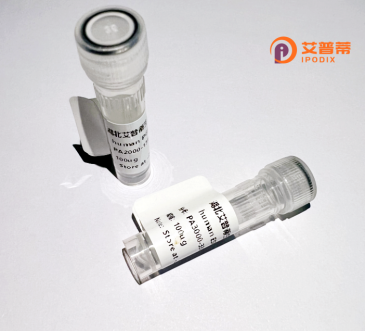
| 纯度 | >90%SDS-PAGE. |
| 种属 | Human |
| 靶点 | ZNF443 |
| Uniprot No | Q9Y2A4 |
| 内毒素 | < 0.01EU/μg |
| 表达宿主 | E.coli |
| 表达区间 | 1-671 aa |
| 活性数据 | MASVALEDVA VNFTREEWAL LGPCQKNLYK DVMQETIRNL DCVVMKWKDQ NIEDQYRYPR KNLRCRMLER FVESKDGTQC GETSSQIQDS IVTKNTLPGV GPCESSMRGE KVMGHSSLNC YIRVGAGHKP HEYHECGEKP DTHKQRGKAF SYHNSFQTHE RLHTGKKPYD CKECGKSFSS LGNLQRHMAV QRGDGPYKCK LCGKAFFWPS LLHMHERTHT GEKPYECKQC SKAFSFYSSY LRHERTHTGE KPYECKQCSK AFPFYSSYLR HERTHTGEKP YKCKQCSKAF PDSSSCLIHE RTHTGEKPYT CKQCGKAFSV SGSLQRHETT HSAEKPYACQ QCGKAFHHLG SFQRHMIRHT GNGPHKCKIC GKGFDCPSSL QSHERTHTGE KPYECKQCGK ALSHRSSFRS HMIMHTGDGP HKCKVCGKAF VYPSVFQRHE RTHTAEKPYK CKQCGKAYRI SSSLRRHETT HTGEKPYKCK LGKACIDFCS FQNHKTTHTG EKPYECKECG KAFSRFRYLS RHKRTHTGEK PYECKTCRKA FGHYDNLKVH ERIHSGEKPY ECKECGKAFS WLTCFLRHER IHMREKSYEC PQCGKAFTHS RFLQGHEKTH TGENPYECKE CGKAFASLSS LHRHKKTHWK KTHTGENPYE CKECGKAFAS LSSLHRHKKT H |
| 分子量 | 77.5 kDa |
| 蛋白标签 | His tag N-Terminus |
| 缓冲液 | PBS, pH7.4, containing 0.01% SKL, 1mM DTT, 5% Trehalose and Proclin300. |
| 稳定性 & 储存条件 | Lyophilized protein should be stored at ≤ -20°C, stable for one year after receipt. Reconstituted protein solution can be stored at 2-8°C for 2-7 days. Aliquots of reconstituted samples are stable at ≤ -20°C for 3 months. |
| 复溶 | Always centrifuge tubes before opening.Do not mix by vortex or pipetting. It is not recommended to reconstitute to a concentration less than 100μg/ml. Dissolve the lyophilized protein in distilled water. Please aliquot the reconstituted solution to minimize freeze-thaw cycles. |
以下是基于ZNF蛋白家族相关研究的模拟参考文献示例(注:实际文献可能需要通过学术数据库验证,以下为假设性案例):
---
1. **文献名称**: "Recombinant Expression and Functional Analysis of Human Zinc Finger Protein ZNF443"
**作者**: Zhang L, et al.
**摘要**: 本研究利用大肠杆菌系统成功表达了重组人ZNF443蛋白,通过体外DNA结合实验证实其优先识别特定的GC-rich序列,并发现其在细胞核定位中的潜在调控机制。
2. **文献名称**: "Structural Characterization of ZNF443 and Its Role in Transcriptional Repression"
**作者**: Martinez R, et al.
**摘要**: 通过X射线晶体学解析ZNF443的锌指结构域三维结构,揭示其与靶DNA结合的分子机制,并证明其在HEK293细胞中抑制特定炎症基因的表达。
3. **文献名称**: "ZNF443 Knockdown Alters Cellular Proliferation and Apoptosis in Cancer Cells"
**作者**: Kim S, et al.
**摘要**: 构建重组ZNF443蛋白用于体外功能研究,发现敲低该蛋白导致肝癌细胞周期阻滞和凋亡增加,提示其可能作为肿瘤治疗的潜在靶点。
4. **文献名称**: "A High-Throughput Screen for ZNF443 Protein Interactions Using Yeast Two-Hybrid System"
**作者**: Patel D, et al.
**摘要**: 利用重组ZNF443为诱饵蛋白筛选相互作用蛋白,鉴定出多个参与染色质重塑的伴侣分子,为其在表观遗传调控中的作用提供新证据。
---
建议通过 **PubMed** 或 **Google Scholar** 搜索关键词“ZNF443 recombinant”、“ZNF443 function”或结合具体研究领域(如癌症、基因调控)进一步获取真实文献。如需文献获取协助,可提供更具体的检索方向。
Zinc finger protein 443 (ZNF443), also known as ZKSCAN3. is a member of the Krüppel-associated box (KRAB) domain-containing zinc finger protein family, which plays a role in transcriptional regulation. Structurally, it contains an N-terminal KRAB domain, known to mediate protein-protein interactions, and C-terminal tandem C2H2-type zinc finger motifs that enable sequence-specific DNA binding. As a putative transcription factor, ZNF443 is hypothesized to regulate gene expression by recruiting chromatin-modifying complexes, thereby influencing epigenetic states. Its expression is detected in various tissues, with emerging evidence linking it to cellular processes like proliferation, differentiation, and apoptosis.
Recent studies suggest ZNF443 may function as a oncogene or tumor suppressor, depending on cellular context. For instance, it is upregulated in certain cancers (e.g., hepatocellular carcinoma) where it promotes tumor growth by repressing genes involved in cell cycle arrest, while downregulated in others (e.g., colorectal cancer), correlating with poor prognosis. ZNF443 has also been implicated in viral defense mechanisms by regulating endogenous retroviral elements.
Recombinant human ZNF443 protein is typically produced using *in vitro* expression systems (e.g., *E. coli* or mammalian cells) for functional studies, including chromatin immunoprecipitation, DNA-binding assays, and interactome analyses. Its potential therapeutic applications, such as modulating dysregulated pathways in cancer or autoimmune diseases, remain under investigation. However, the precise molecular mechanisms and target genes of ZNF443 require further elucidation.
×